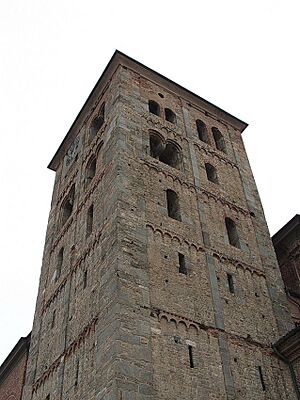Abbey of Fruttuaria facts for kids
Fruttuaria Abbey is a very old and important abbey (a type of monastery) located in a town called San Benigno Canavese. This town is in northern Italy, about 20 kilometers (12 miles) north of a big city named Turin. It has a long and interesting history, starting over 1000 years ago!
The Abbey's Early Days
The Fruttuaria Abbey was founded by a man named Guglielmo da Volpiano. He gave the land for the abbey to be built. The very first stone for the main church was placed on February 23, 1003. This church was built in a style called Romanesque architecture, which means it had thick walls and round arches.
Many important people were there when the church was started. These included Ottobiano, who was the bishop of Ivrea, and Arduin of Ivrea, who was a powerful leader and even a King of Italy. His wife, Berta, was also present.
The entire monastery was finished a few years later, around 1006 or 1007. The monks who lived there followed the Benedictine rule. This was a special set of rules for monks that had been updated by a famous monastery called Cluny. King Arduin even retired to Fruttuaria Abbey before he passed away in December 1015.
In 1027, the abbey became even more important. Pope John XIX issued a special order called a papal bull. This order placed Fruttuaria Abbey and all its lands directly under the Pope's control. This meant it was a very special place.
Another important person who supported Fruttuaria was Empress Agnes. She was a powerful ruler who visited the abbey in 1065. She helped spread the Benedictine customs from Fruttuaria to other monasteries, like Saint Blaise Abbey in Germany.
Times of Greatness
The Fruttuaria Abbey was at its most famous and powerful during the 1100s and 1200s. It was so important that it even had its own mint! This means the abbey could make its own coins.
By 1265, the abbey owned a lot of property. It had 85 churches just in Italy! It also controlled four towns, which were called the quattro terre abbaziali. These towns were San Benigno Canavese, Montanaro, Lombardore, and Foglizzo. The abbey also owned land in other countries, like France and Austria. At its peak, about 1,200 monks lived in the monastery.
Changes Over Time
In the 1300s, the abbey started to become less powerful. A big change happened in 1477. The monks lost their right to choose their own abbot (the head of the monastery). Instead, the Pope started choosing an abbot who often didn't live at the abbey. This abbot would then appoint a vicar to manage things on site.
In 1585, Pope Sixtus V officially closed the monastery. Instead of monks, a group of regular priests took over the buildings. The last monk at Fruttuaria Abbey died in 1634.
Later, in 1710, soldiers from Victor Amadeus II, who was the duke of Savoy, took control of the abbey's lands. This control lasted until 1741, when the Pope finally gave up all his power over the territory.
In 1749, a new abbot named Carlo Vittorio Amedeo delle Lanze took charge of Fruttuaria. In 1770, he decided to tear down most of the old Romanesque church and monastery. Only the campanile (bell tower) and parts of the apse (the rounded end of the church) were saved.
A new church was built in its place. This new church was designed in a late-Baroque style, which is a grand and decorative style. The first design was by Bernardo Antonio Vittone, and it was finished by Mario Quarini. The original church had three main sections and a large transept (the part that crosses the main body of the church), with many small chapels.
In 1979, during work to install heating, something amazing was found! Workers discovered an 11th-century mosaic floor. This mosaic showed two griffons (mythical creatures) with beautiful plant designs. Later excavations (digging) helped uncover the foundations of the original Romanesque church. The restoration work on the abbey was completed in May 2004.
Today, the church has a classic temple-like front. It features a triangular top part called a tympanum. This is supported by large, decorative columns known as Corinthian columns.
Sources


